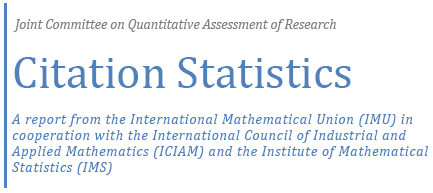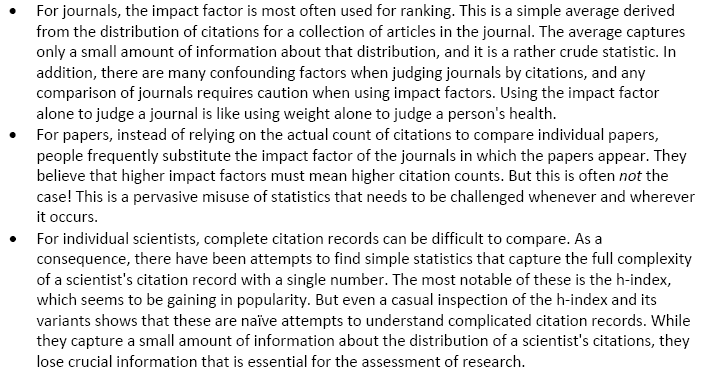|
News & Views item - June
2008 |
 Citation
Statistics -- a Report from the IMU in Cooperation with the ICIAM and the IMS.
(June 22, 2008)
Citation
Statistics -- a Report from the IMU in Cooperation with the ICIAM and the IMS.
(June 22, 2008)

The Joint IMU/ICIAM/IMS Committee on Quantitative Assessment of Research
consisted of Robert Adler from the Technion, Israel Institute of Technology,
John Ewing (Chair) of the American Mathematical Society and Peter Taylor,
University of Melbourne, Australia have released a critical analysis of citation
statistics and journal impact.
The defining statement of the report is summarised as:
The drive towards more transparency and accountability in the academic world
has created a "culture of numbers" in which institutions and individuals believe
that fair decisions can be reached by algorithmic evaluation of some statistical
data; unable to measure quality (the ultimate goal), decision-makers replace
quality by numbers that they can measure. This trend calls for comment from
those who professionally "deal with numbers". mathematicians and statistician.
As Kim Carr, the Minister for Innovation, Industry, Science and Research,
continues his drive for an overwhelmingly citation-based ERA (Excellence
for Research in Australia) layer additional to the assessment of research grant
applications by the Australian Research Council and the National Health and
Medical Research Council the fact is it will utilize no more data than available
to the ARC and NHMRC.
In fact the information utilized will be less and older and the mechanism of
assessment shallower.
The joint committee makes the following principal points in its
26-page report but whether or not the the Prime Minister
and his Cabinet are prepared to take notice is a moot question.

The report continues: "Using citation data to assess research ultimately means
using citation-based statistics to rank things, journals, papers, people,
programs, and disciplines. The statistical tools used to rank these things are
often misunderstood and misused." It then details its viewpoint:

And the report's authors give us one of those memorable think on this
assessments:
In her 1988 paper on the meaning of citations Cozzens1
asserts that citations are the result of two systems underlying the conduct of
scientific publication, one a "reward" system and the other "rhetorical." The
first kind have the meaning most often associated with a citation—an
acknowledgment that the citing paper has "intellectual debt" to the cited. The
second, however, have a meaning quite different—a reference to a previous paper
that explains some result, perhaps not a result of the cited author at all. Such
rhetorical citations are merely a way to carry on a scientific conversation, not
establish intellectual indebtedness. Of course, in some cases, a citation can
have both meanings.
Cozzens makes the observation that most citations are rhetorical.
They hammer the point home with: "This mystical belief in the magic of citation
statistics can be found throughout the documentation for research assessment
exercises, both national and institutional. It can also be found in the work of
those promoting the h-index and its variants... [I]n most cases in which
citation statistics are used to rank papers, people, and programs, no specific
model is specified in advance. Instead, the data itself suggests a model, which
is often vague. A circular process seems to rank objects higher because they are
ranked higher (in the database). There is frequently scant attention to
uncertainty in any of these rankings, and little analysis of how that
uncertainty (for example, annual variations in the impact factor) would affect
the rankings. Finally, confounding factors (for example, the particular
discipline, the type of articles a journal publishes, whether a particular
scientist is an experimentalist or theoretician) are frequently ignored in such
rankings, especially when carried out in national performance assessments."
We have been told by Professor Margaret Sheil, CEO of the ARC, that the Department of Innovation, Industry, Science and Research in
consultation with the ARC and the NHMRC will develop the
criteria for the ERA .
.
Are we really to believe that the resources that are to be expended on this
exercise are going to be worthwhile in raising the quality of Australian research or is
Brian Cox
spot on when he says: The notion that scientists will make a
more valuable contribution to the economic and social wellbeing of the world
if their research is closely directed by politicians is the most astonishing
piece of nonsense I have had the misfortune to come across in a long time.
Concurrent with the publication of Citation Statistics, Nature
published this cameo:
From the blogosphere
Does research need new
measuring sticks? The Nature Network group 'Citation in Science' (http://tinyurl.com/6afj8a)
hopes to find common ground among researchers,
funders, information providers and others concerning the measures of
research output.
Allan Sudlow of the British Library lists common ways
in which citations are manipulated or otherwise abused. 'The art of
counting', a post by Nature product developer Ian Mulvany, is a useful
account of how the impact factor and the H-index are calculated, and
concludes that there are many growing areas of contribution such as blogs
and open data sets that, at present, are ignored by such metrics. Another
post explores whether the number of times an article is downloaded from the
Internet could be more informative than its citation counts.
Biologist David Colquhoun of University College
London argues that publication metrics are inappropriate for assessing
people: "The pressure to produce cheap headline-grabbing work will be
enormous. The long-term reputation of UK science will surely be damaged by
this sort of bean-counting approach."
_______________________________
1Cozzens, Susan E. 1989. What do citations count?
The rhetoric-first model. Scientometrics, Vol 15, Nos 5-6, (1989),
pp. 437-447.
http://dx.doi.org/10.1007/BF02017064



